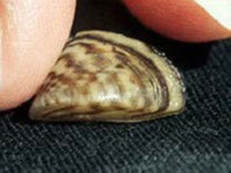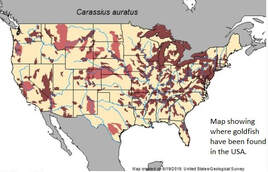Invasive Species Food WEb Lesson Plans
New lesson plan ideas are welcome. See below for instructions on submitting.
All lesson plans may be downloaded and used FOR FREE!!!
All lesson plans may be downloaded and used FOR FREE!!!

Invading the Invaders: Impacts of Zebra and Quagga Mussels
by Nicole Samuel
This lesson plan explores how zebra mussels and quagga mussels have changed food webs in the Great Lakes by filtering plankton from the lakes. It includes a hands-on activity that demonstrates how mucus produced by the mussels may bind the floating plankton to concentrate it on the bottom of the lakes. For Grades 5 and 6 science.
by Nicole Samuel
This lesson plan explores how zebra mussels and quagga mussels have changed food webs in the Great Lakes by filtering plankton from the lakes. It includes a hands-on activity that demonstrates how mucus produced by the mussels may bind the floating plankton to concentrate it on the bottom of the lakes. For Grades 5 and 6 science.

Lake Michigan Food Web and Sea Lamprey
by Bill Hodges
Students explore the meaning of food webs and how invasive species like the sea lamprey have changed them. Hands-on activities include using "species cards" of Great Lakes and non-native organisms to create and modify food webs. For Middle School and High School students.
by Bill Hodges
Students explore the meaning of food webs and how invasive species like the sea lamprey have changed them. Hands-on activities include using "species cards" of Great Lakes and non-native organisms to create and modify food webs. For Middle School and High School students.

Great Lakes Food Webs: Impacts of Invasive Species on Lake Huron Food Web
by Erica Sprague
This lesson focuses on the effect of invasive species in the Lake Huron Food Web. They will identify the invaders as producers, consumers, decomposers or scavengers and investigate how the food web could potentially change as a result of the invasive species. For middle school science, grades 6 - 8.
by Erica Sprague
This lesson focuses on the effect of invasive species in the Lake Huron Food Web. They will identify the invaders as producers, consumers, decomposers or scavengers and investigate how the food web could potentially change as a result of the invasive species. For middle school science, grades 6 - 8.

Earthworm Invaders
by Erica Sprague
This lesson focuses on the role of earthworms in food webs and the devastating effect invasive earthworms are having on some forest ecosystems in the United States. Students study potential similar impacts in the Great Lakes region and how people can slow the spread. Students will learn about earthworm species, why they can be considered invasive, and do a lab to collect earthworms around the school as part of a place-based learning experience. For middle school science, grades 6 - 8.
by Erica Sprague
This lesson focuses on the role of earthworms in food webs and the devastating effect invasive earthworms are having on some forest ecosystems in the United States. Students study potential similar impacts in the Great Lakes region and how people can slow the spread. Students will learn about earthworm species, why they can be considered invasive, and do a lab to collect earthworms around the school as part of a place-based learning experience. For middle school science, grades 6 - 8.

Tangled Web of Life
by Katie Larson
Students use yarn to create a web of connections between Great Lakes species,. They discuss the complexity of the web and discover the impacts of changes to the web. Students will explore the feeding relationships in an ecosystem, as well as the different plants and animals that inhabit the Great Lakes. The focus is on native species, but the lesson also provides an opportunity to introduce invasive species to the yarn food web and highlight their impact.
For middle school science, grades 6 - 8.
by Katie Larson
Students use yarn to create a web of connections between Great Lakes species,. They discuss the complexity of the web and discover the impacts of changes to the web. Students will explore the feeding relationships in an ecosystem, as well as the different plants and animals that inhabit the Great Lakes. The focus is on native species, but the lesson also provides an opportunity to introduce invasive species to the yarn food web and highlight their impact.
For middle school science, grades 6 - 8.

Golden Invaders
by Marcerlean Green, Dossin elementary, Detroit, MI
Students will investigate how goldfish got into the Great Lakes and whether they are invasive species. The students will create informational text that will provide information on GOLDFISH and their invasive habits in the great lakes. Together, students will create a Great Lakes food chain with and without GOLDFISH and will explore the questions: Could goldfish be the cause of algal blooms in a lake? Are they the cause of the algal bloom in Lake Erie? For Grade 5 students
by Marcerlean Green, Dossin elementary, Detroit, MI
Students will investigate how goldfish got into the Great Lakes and whether they are invasive species. The students will create informational text that will provide information on GOLDFISH and their invasive habits in the great lakes. Together, students will create a Great Lakes food chain with and without GOLDFISH and will explore the questions: Could goldfish be the cause of algal blooms in a lake? Are they the cause of the algal bloom in Lake Erie? For Grade 5 students

New lesson plan ideas are welcome and will be uploaded as they are received and approved.
Instructions for submitting lesson plans for:
About invasive species,
About science and science careers
For information about submitting new lesson plans, please contact jchadde(at)mtu.edu
Lesson plan ideas from other web sites:
From Pennsylvania Sea Grant: 10 lesson plans about interactions of invasive species, biodiversity, and climate change
Creation of the above page of educational resources was funded in part by the Michigan Invasive Species Grant Program through the Departments of Natural Resources, Environmental Quality, and Agricultural and Rural Development.
This material is also based upon work supported by the National Science Foundation under Grant No. 1614187.
Any opinions, findings, and conclusions or recommendations expressed in this material are those of the authors and do not necessarily reflect the views of the National Science Foundation.
Instructions for submitting lesson plans for:
About invasive species,
About science and science careers
For information about submitting new lesson plans, please contact jchadde(at)mtu.edu
Lesson plan ideas from other web sites:
From Pennsylvania Sea Grant: 10 lesson plans about interactions of invasive species, biodiversity, and climate change
Creation of the above page of educational resources was funded in part by the Michigan Invasive Species Grant Program through the Departments of Natural Resources, Environmental Quality, and Agricultural and Rural Development.
This material is also based upon work supported by the National Science Foundation under Grant No. 1614187.
Any opinions, findings, and conclusions or recommendations expressed in this material are those of the authors and do not necessarily reflect the views of the National Science Foundation.